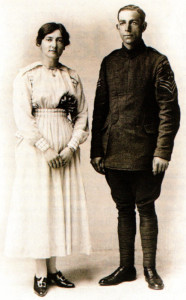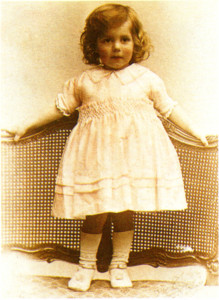
In the beginning there was fog, part of which never really lifted from my mind throughout life, with all its unanswered questions. A dense blanket of it had enveloped Windsor the morning I arrived in the Royal Borough on October 7 1918, so they tell me.
My mother had a kind, unassuming husband who was looking forward to being reunited with her when the Great War was over. She had everything to live for, but gave her life for me when she died three hours after my birth. My father died when I was seven.
When the fog cleared, the end of that day yielded to the creeping ash of night and that evening, 22 days before Hallowtide, owls called mournfully from the park. Venus, the evening sta

r, which shines brightest in May and October, was as near to the Earth as it would ever be to light our way from here to eternity.
On Armistice Day – November 11 1920 -my grandfather and aunts joined the crowd for the unveiling of the Cenotaph and witnessed the coffin of the Unknown Warrior, that nameless hero of the battlefields, being carried along Whitehall, where his body was to lie among the royal dust at Westminster.
On my Grandma Alice’s birthday, a girl with an English complexion married
Viscount Lascelles. She was of course Princess Mary, newly-created Princess Royal, the only daughter of King George V and Queen Mary. While Gran’s birthday cake was baking sweetly in the oven her nephew Frederick Craske, a slim young man with blue twinkling eyes, made complimentary remarks about her culinary achievements. Later he was to become Bishop of Gibraltar, afterwards Assistant Bishop of London.
At the age of one year and ten months, attired in a pink silk smocked dress (the sleeves and collar trimmed with lace), wearing white socks and slippers with pompoms, I was accompanied by my Aunt Nancy and Aunt Lilian to Richmond, where the accompanying photograph was taken. We then went to Kew Gardens, where a pelican gave me an unexpected peck which just missed my eye, grazing the corner.
On my birthday, October 7 1922 Marie Lloyd, one of the best beloved of all our music hall performers, died.
The year 1923 brought about the successful results of my childish persuasion, a cream tea at Togni’s in Peascod Street, with my father and his brother Bill home on leave from the P&O Line. I remember the pretty pink-cheeked ‘nippies’ wearing their Lyon’s caps and dainty aprons.
Such delightful days of freedom would soon draw to a close with the start of school life on the horizon. On February 16 came the news that Lord Caernarvon had entered the tomb of Tutankhamen, and on April 23 King George V opened the British Empire Exhibition at Wembley. I recall keeping my friend Bessie company while her parents attended the exhibition at some point during its six-month opening.
To make up for the lack of brothers and sisters I enjoyed the friendship of the neighbouring children includingjoan, who took me to meet the teachers at Spital School. She tells me that Miss Meanwell gave me some ‘satin cushion’ sweets that day. I recall vividly seeing the flags and bunting fluttering over our heads above the playground to mark the wedding on April 26 of the Duke of York to Lady Elizabeth Bowes-Lyon, now the Queen Mother.
With other young friends I was a proud member of Teddy Tail’s Club, and I was rewarded for my first sketch which appeared in the Children’s Daily Mail by the princely sum of 5/-. After this I wrote a few verses which were also printed.
The lure of Parnassus beckoned, leaving the art field open to Messrs. Monet, Bonnard and Utrillo! Despite my obsession with the Children’s Daily Mail the large paper intrigued me also. Mr. Baldwin became Premier on May 28 and I remember clearly seeing pictures of Tokyo and Yokohama, almost razed to the ground by the most appalling earthquakes ever recorded. This happened in September, when 100,000 people perished and half as many again were reported missing.
Our formidable governess of the 1920s will be well remembered. Naughty little boys were caned unmercifully by her, ad nauseam. The outstretched palms of the girls were numbed by the ridged wooden back of the blackboard rubber. I suffered once through the effects of the aforementioned fog which was apt to clog my mind at the worst moments, trapping it in one of the numerous ‘don’t know’ blocks. I received punishment promptly, but don’t think I ever bore resentment, and certainly do not now.
Those dedicated teachers did a fine job. They were married to the school, with no loving husband to come home to and no children or grandchildren to care for.
Among the pupils I remember those who lived in the vicinity of my home – Bessie Castle, Alfred and Frances Brown, Bobby Copas with a mop of golden curls, Fred Bridges, whose auntie kept the sweet shop, Vera Wilkins, Gwen Helmuth and her young brother Ted, Tommy Jones, who lived near Stag Meadow Gate and Ronnie Culley, who lived in the lodge there. I recall Algy and Freddie Bartholemew from Hermitage Lane, Alan Roberts, Gladys and Jack Field, Leslie Lovegrove and Dennis Saunders. There was Freddie Young, the lone long-distance traveller who often came to school by bus. He lived on the Railton estate in Windsor Forest.
Barbara Todman and Irene Haines lived near the school, and there were two sets of twins, each with a fair and dark sister – Jean and Joan Blake and the Wilson twins from Bolton Road. From that area also came Dora East, Eric White, Marjorie Nash, Connie Simms, Eva Turner and the barrack children. Included among those were Joan Wooton, George Woods and Cynthia Peel. Perhaps some of them read Best of British today!
I summed up my feelings for the school in verse, and thought your readers might like it:
The Village School
This little red brick school, unchanged, intact,
Built eighteen seventy four, to be exact.
A sturdy pile, surviving two world wars, Stood to remind me of so many things That made my youthful heaven of yesteryear
On the whole, a very happy one.
In retrospect, I am so well aware Of the concern, the time, the patience, care The teachers gave to do their best for us. Memories of children I knew there Come back to me like flowers to the spring, Recalling squeals ofjoy at sight of snow, The Christmas tree with all its lights aglow. For as the carols echo down the years And children in the choir begin to sing,
I am not through with my remembering.
Rosemary Young








